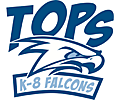Social-Emotional Learning Curriculum
Dear TOPS K-5 families,
Since September 2019, I have been delivering weekly guidance lessons in Social-Emotional learning (SEL) in K-5 classrooms. In Kindergarten, so far, we have been using the Kelso?s Choice curriculum, and in 1st ? 5th grades, we have been using Kelso?s Choice, Second Step Bullying Prevention and RULER. Schoolwide, we have monthly community themes that are introduced in our monthly SEL assemblies and discussed in classrooms. In this letter, I would like to outline the topics discussed in each curriculum, so you can discuss these topics at home with your student. When possible, I will also send take-home worksheets with students to help guide your conversations.
- RULER (Yale Center for Emotional Intelligence)
- Goals: To help students learn how to recognize, understand, label, express and regulate feelings in themselves and others. Additionally, students develop a larger feelings vocabulary and learn to use empathy as a key part of problem-solving.
- Anchor Charts:
- Charter (introduced in September)- Classrooms and grades identify how they want to feel, what they are willing to do to feel this way and how to resolve conflict, when people are not following the Charter
- Mood Meter (introduced in October)- Students learn to identify how they are feeling and strategies for shifting feelings, if their feelings are not useful
- Meta-moment (introduced in February)- Six-step process for meta-cognition (something happens, sensing, stopping, visualizing one?s best self, picking a strategy, recognizing success)
- Blueprint (introduced in April)- problem-solving by a) recognizing and labeling feelings in self and others; b) understanding the cause of each person?s feelings; c) noticing how each person expressed and regulated feelings; d) reflecting and planning resolution
- Second Step Bullying Prevention Unit (Committee for Children)
- Goals: To help students recognize bullying and develop strategies for dealing with bullying.
- Lessons:
- Recognizing Bullying
- Reporting Bullying
- Refusing Bullying
- Bystander Power
- Kelso’s Choice
- Goals: To help students differentiate between ?big? and ?small? problems, identify trusted adults and learn how to use strategies for solving ?small? (not dangerous) problems. Older students learn to differentiate between ?verbal? and ?nonverbal? strategies.
- Choices:
- Talk It Out
- Share and Take Turns (K-3, only)
- Ignore It
- Walk Away
- Tell Them to Stop
- Apologize
- Make a Deal
- Wait and Cool Off
- Community Themes (presented in monthly assemblies and discussed in classrooms)
- Goals: To create a school-wide community focus (themes taught in spoken English and ASL)
- Themes:
- September- Community
- October- Growth Mindset
- November- Empathy
- December- Compassion
- January- Leadership
- February- Stewardship
- March- Self-Management (subject to change)
- April- Compromise (subject to change)
- May- Perseverance (subject to change)
- June- Gratitude (subject to change)
As the year progresses, there will be additional lessons in social skills and emotional regulation. Research has shown that when students feel calm and connected at school, they are more able to learn. We look forward to partnering with families to help students learn the skills they need to be happy and successful, both at TOPS and beyond! If you have any ideas or feedback for me or our Social Emotional Learning team, please feel free to contact me at kbhanson@seattleschools.org.
Kathy Hanson
Counselor, TOPS K-8
kbhanson@seattleschools.org
